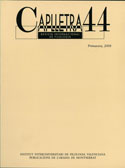Un fals aparegut en el «Tirant lo Blanch»
DOI:
https://doi.org/10.7203/caplletra.44.4798Paraules clau:
Tirant lo Blanc, Rats and Cats, After Death Appearances, Discretio Spiritum, Knightly Parody, Hipòlit Resum
Resum
In the chapters CCXXXI-CCXXXIIII of Tirant lo Blanc, there are two
comical scenes where Carmesina and Tirant attempt to keep their love a secret. Carmesina justifies a night riot happened in her chamber by saying that a rat went through her face; whereas Tirant pretends to be a ghost when he runs away from the chamber into the orchard. The dependence of these two episodes opposes the nature of several characters, but the scene that best exhibits the knights’ ambivalent morality is the appearance of Tirant –with the spells of Hipòlit and the viscount of Branches. The comparison of this case with chapter XIX of the «Quixote», and with other works of the modern age, allows to determine how the forms and the meanings of a same commonplace evolve. The appearance of «Tirant» has to be linked especially to three
mediaeval traditions: in the first place, the «fabliaux» and the «novelle», like the «Llibre de fra Bernat» or the «Decamerone»; in the second place, the treaties of ghosts, according to the outlines of «De spiritu Guidonis»; in the third place, the motif of the knightly
adventure, in the way of Chrétien de Troyes. This is how Joanot Martorell balances and adapts diverse materials to the situations that the case brings up.
 Descàrregues
Descàrregues
Descàrregues
Publicades
Com citar
-
Resum428
-
PDF325
Número
Secció
Llicència
L’autor o autora que adrece un treball a la redacció de Caplletra perquè siga publicat ha de ser la persona titular legítima dels drets d'explotació. La legitimació per a la publicació del treball ha d’incloure també les imatges, les taules, els gràfics i altres materials que puguen complementar el text, amb independència de si n'és l'autor o autora.
Copyright. Quan publica el treball en la revista, l'autor o autora cedeix a Caplletra. Revista Internacional de Filologia els drets d'explotació (reproducció, distribució i comunicació pública), tant per a l'edició impresa en paper com per a la versió electrònica, que serà accessible mitjançant la xarxa Internet.
Tots els treballs publicats en Caplletra es troben sota una llicència Creative Commons del tipus Reconeixement-NoComercial-SenseObraDerivada 4.0.
RESPONSABILITAT
Caplletra. Revista Internacional de Filologia no s'identifica necessàriament amb els punts de vista mantinguts en els treballs que publica.
Caplletra. Revista Internacional de Filologia declina tota responsabilitat derivada de qualsevol vulneració eventual dels drets de propietat intel·lectual que poguera ser duta a terme pels autors o autores.






